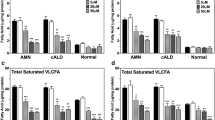Abstract
Lovastatin, an inhibitor of 3-hydroxy-3-methylglutarylcoenzyme A reductase, normalizes the very long-chain fatty acids (VLCFA) concentrations in fibroblasts and plasma from patients with X-linked adrenoleukodystrophy (X-ALD). The effects of lovastatin on the accumulation of VLCFA in tissues of adrenoleukodystrophy protein (ALDP)-deficient mice were assessed. ALDP-deficient mice were fed chow with 0.01–0.1% lovastatin for 4–8 weeks. The VLCFA concentrations in the plasma, brain, spinal cord, liver and kidneys were measured. Treatment with 0.1% lovastatin significantly reduced body weight and total cholesterol in the plasma of ALDP-deficient mice. Treatment with lovastatin, however, did not correct the accumulation of VLCFA in the plasma or tissues, including the brain and spinal cord. Lovastatin does not affect the accumulation of VLCFA in ALDP-deficient tissues in mice.
Similar content being viewed by others
REFERENCES
Allain CC, Poon LS, Chan CS, Richmond W, Fu PC (1974) Enzymatic determination of total serum cholesterol. Clin Chem 20: 470–475.
Duggan DE, Chen I-W, Bayne WF, et al (1989) The physiological disposition of lovastatin. Drug Metab Dispos 17: 166–173.
Folch J, Lees M, Sloane Stanley GH (1957) A simple method for the isolation and puri¢cation of total lipids from animal tissues. J Biol Chem 226: 497–509.
Germershausen JI, Hunt VM, Bostedor RG, et al (1989) Tissue selectivity of the cholesterol-lowering agents lovastatin, simvastatin and pravastatin in rats in vivo. Biochem Biophys Res Commun 158: 667–675.
Hamelin BA, Turgeon J (1998) Hydrophilicity/lipophilicity: relevance for the pharmacology and clinical e¡ects of HMG-CoA reductase inhibitors. TiPS 19: 26–37.
Kamijo K, Taketani S, Yokota S, Osumi T, Hashimoto T (1990) The 70-kDa peroxisomal membrane protein is a member of theMdr (P-glycoprotein)-related ATP-binding protein superfamily. J Biol Chem 265: 4534–4540.
Kemp S, Wei H-M, Lu J-F, et al (1998) Gene redundancy and pharmacological gene therapy: implications for X-linked adrenoleukodystrophy. Nature Medicine 4: 1261–1268.
Kobayashi T, Katayama M, Suzuki S, Tomoda H, Goto I, Kuroiwa Y (1983) Adrenoleukodystrophy: detection of increased very long chain fatty acids by high-performance liquid chromatography. JNeurol 230: 209–215.
Kobayashi T, Shinnoh N, Kondo A, Yamada T (1997) Adrenoleukodystrophy protein-de¢cient mice represent abnormality of very long chain fatty acid metabolism. Biochem Biophys Res Commun 232: 631–636.
Koga T, Fukuda K, Shimada Y, et al (1992) Tissue selectivity of pravastatin sodium, lovastatin and simvastatin. The relationship between inhibition of de novo sterol synthesis and active drug concen-trations in the liver, spleen and testis in rat. Eur J Biochem 209: 315–319.
Lombard-Platet G, Savary S, Sarde C-O, Mandel J-L, Chimini G (1996) A close relative of the adrenoleukodystrophy (ALD) gene codes for a peroxisomal protein with a speci¢c expression pattern. Proc Natl Acad Sci USA 93: 1265–1269.
Lopez JM, Bennett MK, Sanchez HB, Rosenfeld JM, Osborne TF (1996) Sterol regulation of acetyl coenzyme A carboxylase: a mechanism for coordinate control of cellular lipid. Proc Natl Acad Sci USA 93: 1049–1053.
Moser HW, Smith KD, Moser AB (1995) X-linked adrenoleukodystrophy. In: Scriver CR, Beaudet AL, Sly WS, Valle D, eds. The Metabolic and Molecular Bases of Inherited Disease. New York: McGraw-Hill, 2325–2350.
Mosser J, Douar A-M, Sarde C-O, et al (1993) Putative X-linked adrenoleukodystrophy gene shares unexpected homology with ABC transporters. Nature 361: 726–730.
Netik A, Forss-Petter S, Holzinger A, Molzer B, Unterrainer G, Berger J (1999) Adrenoleukodystrophy-related protein can compensate functionally for adrenoleukodystrophy protein de¢ciency (X-ALD): implications for therapy. Hum Mol Genet 8: 907–913.
Shani N, Jimenez-Sanchez G, Steel G, Dean M, Valle D (1997) Identi¢cation of a fourth half ABC trans-porter in the human peroxisomal membrane. Hum Mol Genet 6: 1925–1931.
Singh I, Pahan K, Khan M(1998a) Lovastatin and sodium phenylacetate normalize the levels of very long chain fatty acids in skin ¢broblasts of X-adrenoleukodystrophy. FEBS Lett 426: 342–346.
Singh I, Khan M, Key L, Pai S (1998b) Lovastatin for X-linked adrenoleukodystrophy. NEngl JMed 339: 702–703.
Yamada T, Taniwaki T, Shinnoh N, et al (1999) Adrenoleukodystrophy protein enhances association of very long-chain acyl-coenzyme A synthetase with the peroxisome. Neurology 52: 614–616.
Author information
Authors and Affiliations
Rights and permissions
About this article
Cite this article
Yamada, T., Shinnoh, N., Taniwaki, T. et al. Lovastatin does not correct the accumulation of very long-chain fatty acids in tissues of adrenoleukodystrophy protein-deficient mice. J Inherit Metab Dis 23, 607–614 (2000). https://doi.org/10.1023/A:1005634130286
Issue Date:
DOI: https://doi.org/10.1023/A:1005634130286




